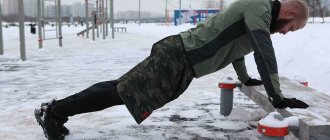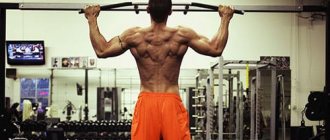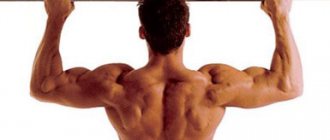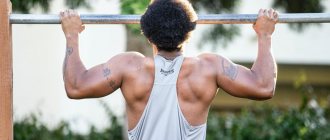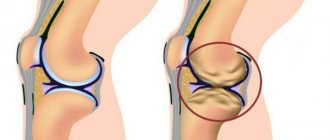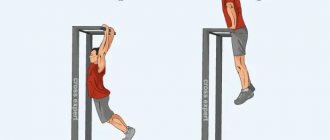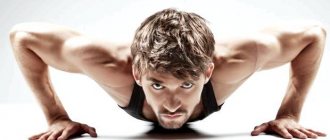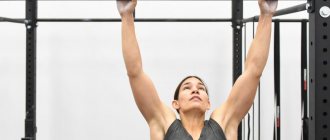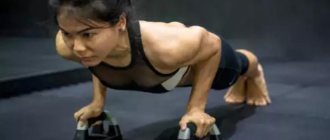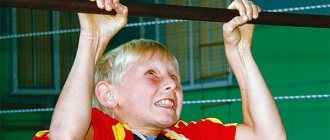learn to do pull-ups on the horizontal bar from scratch: a set of exercises for beginners
06/05/2016 Training
In this article we will tell you how to learn how to do pull-ups on a horizontal bar from scratch. In order for you to master this exercise, even if you cannot do a single pull-up yet, we have selected a set of simple auxiliary exercises that will tell you which muscles you need to pump in order to do pull-ups on the horizontal bar. And how to do it correctly.
To perform pull-ups, strong arms alone are not enough. To learn how to do pull-ups on a horizontal bar, you need to develop the strength of the auxiliary muscles of the back and the mobility of the joints. If you work out regularly and actively in the gym or do HIIT workouts, but still can't get your chin to the bar, you're not alone.
Generally, pull-ups are considered an upper-body exercise, but if you want to improve technique in your shoulders, shoulder blades, and thoracic spine, you'll need stability and tension in the rest of your body to do them.
In short, pull-ups are a difficult exercise. You hang from the bar and then pull your body weight up. Pull-ups are perhaps the best indicator of strength. That is, they demonstrate how strong you are relative to your own weight. If you've ever done other bodyweight exercises (like push-ups or planks) or any yoga pose that relies on your forearms, you know how difficult it can be.
Another important point to keep in mind is shoulder mobility. Good mobility of the thoracic region and shoulders allows you to use the latissimus dorsi muscles - the main working muscles in this exercise. If the shoulder girdle does not have the necessary level of mobility, stability and coordination, then performing pull-ups correctly becomes almost impossible.
How to prepare for pull-ups
These build-up exercises will work all the muscle groups needed for pull-ups and improve neuromuscular coordination in this movement.
Your workout will look like this:
- Shoulder engagement - 5 sets of 10 seconds.
- Hold at the top point - 5 sets of 60 seconds. Or negative pull-ups - 3 sets of 15 reps.
- Australian pull-ups - 5 sets of 10 reps.
- Pull-ups with an elastic band or with support on a chair - 5 approaches at close range.
Perform it every other day so that the muscles have time to rest and recover.
Shoulder engagement while hanging on a horizontal bar
Hanging Back Muscle Activation
This exercise will improve your grip strength and help you remember the correct starting position.
Grasp the horizontal bar with an overhand grip so that your palms are slightly wider than your shoulders. Hang by straight arms. Tighten your abs, lower your shoulders and squeeze your shoulder blades together. Maintain this position for 10–15 seconds. Repeat 5 times.
Always do the exercise, even when it becomes easy. This is a great shoulder warm-up before doing pull-ups.
Holding at the top
Grab the bar with an overhand grip and jump up to reach the top of the pull-up with your head above the bar.
Hold this position for 60 seconds. Perform 5 approaches. If you can't hold on for a minute, do as much as you can, but try to increase the time each time.
When you get to one minute, replace this exercise with negative pull-ups.
Negative pull-ups
Jump onto the horizontal bar and do a pull-up using the momentum of the jump. If your pull-up bar hangs too high, substitute a chair. Pause at the top and lower as slowly as possible.
Perform 3 sets of 10–15 negative pull-ups.
Australian pull-ups
To do this, you will need a low bar, a barbell on racks, or even a mop placed on two high chairs. The only requirement is that the bar must be high enough so that you can fully straighten your arms while hanging.
Grasp the bar with an overhand grip, leave your feet on the floor, and extend your body in one line. Pull yourself up to the bar, touch it with your chest, and then lower yourself back down. The body is always elongated in one line, the abs and buttocks are tense so that the butt does not sag down.
Perform five sets of 10–15 repetitions.
Pull-ups with an elastic band or chair support
If you have a resistance band, hook it to a bar, place one or both legs in the loop, and do pull-ups. The tape will take some of the load off and it will be easier for you.
If you have access to a set of resistance bands, start with the thicker ones with more resistance and work your way up to the thinner ones.
If you don't have a rubber band, place your feet on a chair. Relax them and try to help yourself as little as possible in pulling yourself up.
Perform 5 sets of as many reps as you can.
Once you can complete 10 reps with an assisted set, you can try unassisted pull-ups.
#6 Adopt a gravitron
Pull-ups in a gravitron
Gravitron is a special simulator that can be found in almost any gym. Its specificity is in the platform, which goes up, compensating for part of the weight of your body. But this feature is not important to us! In the gravitron, the platform rises with you and serves as an additional point of support, from which the swaying of the body is eliminated. So if all else fails or you are just learning how to do pull-ups correctly, the gravitron is the way to go.
pull-up bar
How to do pull-ups
What should be the grip?
With a reverse grip, the load shifts to the biceps of the shoulder, while a straight grip puts more strain on the back muscles. It's easier to do pull-ups with a reverse grip, so use that first.
Once you can perform the exercise with good technique, switch to an overhand grip.
What is the starting position
Hang from the horizontal bar. Initially, your shoulders cover your ears. Now lower your shoulders and squeeze your shoulder blades together, tighten your abs, twist your pelvis a little forward. From this tense position you will perform pull-ups, and you must return to it.
If your horizontal bar is low, you can move your legs slightly forward and bend them. The angle between the body and hips is about 40–45 degrees.
There is no need to bend your legs to a right angle, as if you were sitting on a chair. This pumps up the hip flexors, but at the same time stretches the latissimus dorsi and robs them of some of their strength.
How to climb
Pull yourself up until your chin goes beyond the level of the horizontal bar. Do not relax your back: at the top point, the shoulder blades should be collected, as in the starting position, and the chest should be pulled forward.
Don't swing or jerk. The movement should be smooth and controlled. You rise strictly vertically and descend in exactly the same way.
Don't pull your chin up while trying to complete your approach. The head and neck do not change position until the end of the exercise. Keep your pelvis tucked, straighten your legs slightly forward, tense them.
How to get down
Lower yourself smoothly, without jerking or falling.
Perform full range of pull-ups until your elbows are fully extended. You can do more partial pull-ups, but the muscles will not receive the necessary load.
Do not relax your shoulders at the bottom point, maintain the original tense position.
How to relax
After finishing the approach, rest for 1-2 minutes. By resting less, you won’t be able to give your best in the next approach; if you rest more, you risk cooling down, so it will be more difficult to start the approach.
What are the dangers of using the wrong technique?
In the case when the skill of controlling one’s own body is not sufficiently developed and the muscles are not strong enough, the body begins to look for other ways to redistribute energy, using the already mentioned inertial force and natural anatomical levers, which leads to the fact that a considerable load is placed on the still unprepared muscles and ligaments. This in turn can cause injury.
An athlete with an insufficiently developed shoulder girdle includes the hands, arms, shoulders and back in the work, performing pull-ups with swinging - but at the same time, due to the incorrect technique of performing the movement, numerous ligaments of the lower half of the body are included in the work. These tissues are not fully designed for this type of load - and therefore excessive zeal can be traumatic.
The CrossFit Specialty Course: Gymnastics Training Guide says: “Injuries are caused by excessive stress placed on the biceps and shoulder stabilizers. The same thing happens when an athlete has enough strength to push the barbell, but then drops the barbell, completely without control of the descent.”
What to do if it doesn't work out
Pull-ups are a difficult exercise, especially if you have no athletic experience. So don't be discouraged if you don't do much in the first month or two or if you can't do any pull-ups without support yet. This is especially true for girls with weaker shoulder girdles than men.
To strengthen the muscles you need, try some exercises using machines and free weights.
Upper pulley to chest
This exercise will help pump up the latissimus muscles, which perform the main Surface electromyographic activation patterns and elbow joint motion during a pull-up, chin-up, or perfect-pullup™ rotational exercise., Electromyographical Comparison of a Traditional, Suspension Device, and Towel Pull-Up work in pull-ups on the horizontal bar.
Sit on a bench, grab the handle with a reverse grip. Straighten your back, bring your shoulder blades together, press your feet firmly to the floor. Pull the handle towards your chest until it touches without changing the position of your back. Return and repeat. Perform the exercise smoothly, without jerking or swinging.
Choose a weight for 8-10 reps. The last reps of the set should be difficult. Perform 3-5 approaches.
Bent-over dumbbell raises
This exercise will help pump up the rear deltoid muscles of the shoulders. Take dumbbells in your hands, start with small ones, 2–4 kg. Tilt your body until it is parallel to the floor. Raise your arms with dumbbells to the sides and slightly forward, return and repeat.
Perform 3 sets of 10–15 repetitions.
Biceps Curl
The exercise is designed to pump up the biceps brachii; this muscle also bears a huge load in pull-ups.
Hold the barbell with your arms extended. Bend your elbows and bring the barbell to your chest. Lower and repeat. Do 3 sets of 10 reps. Choose a weight so that the last rep of the set is difficult.
Bent-over barbell row
This exercise works the lats well, as well as the trapezius, deltoids, and teres major—a complete pull-up package.
Take the barbell in your outstretched arms, bend over with a straight back, slightly bend your knees. Pull the barbell towards your stomach and then lower it. Perform 5 sets of 8–10 reps. Choose a weight so that the last reps are difficult.
Problems of horizontal bar lovers
Pull-ups are a rather traumatic thing, especially if you haven’t done anything before. Beginners should choose rubber-coated platforms, or horizontal bars that are dug directly into the sandbox, so as not to be injured if they fall. And it is quite real, especially if there are problems with the grip and exorbitant ambitions that do not allow a person to stop training in time.
In addition, the practitioner should always have magnesium on hand to prevent slipping, calluses and damage to the skin.
Injuries
The main way to prevent injury is to normalize your relationship with your own ego. Stop trying to force jump jumps if you don't know how to do a pull-up yet. Do not perform exercises using the force of inertia if you do not yet have enough muscle strength. Try to do everything technically and complete tasks gradually.
Well, here are the classic recommendations - first warm up by lightly running around the site, then by rotating in all the main joints, after that by pulling the rubber to your chest with the shock absorber secured on top.
Calluses
The reason for their occurrence is not excessive work, or even sweaty palms. Usually, calluses plague those who really like to hang on their fingers, and even swing at the same time. From the very first training, learn to make a palm grip so that the body does not sway from side to side and does not perform pendulum movements. This will help get rid of callus problems. If your training volume is high and you are using weights, feel free to use straps. A good grip is great, but regular training without pain and calluses is even better.
In general, some “roughness” of the palms is the norm, and it only helps to stay on the horizontal bar.
Ligament pain
Here it is necessary to distinguish between inflammation of the ligaments and joints, which are dangerous to health, and muscle soreness. Soreness is a normal practice, and it cannot harm your training in any way. On the contrary, you should actively warm up on days that are not heavy training.
But if the ligaments and joints hurt at night, become inflamed, or seem to “tug” when you are at rest, it is better to consult a doctor to rule out health problems.
Falls from the horizontal bar
This is also normal practice; you need to learn to jump softly and onto the surface. But in fact, most often those who do not use magnesium and who have a weak grip fall from horizontal bars. The second category of athletes must simply develop their grip. If the metal of the crossbar is smooth and slippery, it is worth wrapping a medical plaster around the crossbar to ensure normal adhesion to the coating.
Where to start training
Don't skip your warm-up, especially if you work out in the morning. It will take 5-10 minutes and will consist of three parts - the first two are shown in the video below.
- Joint gymnastics : tilts and turns of the head, rotation of the shoulders, elbows and wrists, triple forward bends, rotation of the hips, knees and feet. Perform 5-10 times in each direction.
- Dynamic stretching : bending and deep squatting with a body turn - 3 times, dog pose with a deep lunge forward - 3 times from each leg, side lunges touching the opposite foot - 10 times.
- Short cardio . This could be 20 Jumpig Jacks, 3 sets of 30 seconds of running in place, or 50-100 jumping ropes.
If your site is close to home, you can warm up right there. If you need to get there, do the first two warm-up points at home, and then run to the training place.
Run at a conversational pace—when you can move and still carry on a conversation without getting out of breath. And consider the distance. As a warm-up, you should not run more than 3 km, otherwise you will not have any energy left for the activity.
If the site is further away, you can ride a bike - it’s a great warm-up and gets you ready for a workout.
Precautions during exercise
In any sport, safety precautions must be observed. To avoid unpleasant and hazardous consequences for health, you need to follow the recommendations.
They are as follows:
- Under no circumstances should you exercise on the bar if you have muscle pain.
- It is worth refraining from training in rain, frost and at night.
- Avoid poorly secured structures and do not do pull-ups on old, rusty crossbars.
- Before each workout, warm up your muscles. Running, squats, and push-ups are suitable for warming up.
- All movements should be smooth, without sudden lunges.
- The crossbar should correspond to the height of the athlete so as not to jump too high.
- To avoid damaging the skin on your palms, it is better to use special fitness gloves.
- People suffering from diseases of spinal curvature, protrusion, spinal hernia should refrain from exercising on the crossbar.
Basic mistakes
There are factors that interfere with the process of mastering the projectile. These include:
- Excess weight. If you are overweight, more muscle effort is required to pull up. If your weight exceeds the norm by 20 kilograms or more, then first of all you need to get your shape in order.
- Problems with the cardiovascular system. In a person with a weak heart and blood vessels, when performing an exercise, the blood simply does not have time to pass through the narrow capillaries. As a result, the pressure jumps, the head feels dizzy, and the vision becomes dark. Agree, this greatly interferes with the normal flow of training.
- Poor physical shape. Pull-ups are not given to those who do not have endurance and physical strength.
- Muscle weakness. When performing an exercise, various muscle groups are involved; if some of them are too weak, mastering the exercise may be in question. The success of the event largely depends on the training of small auxiliary muscles, which are not strong enough for most novice athletes.
- Incorrect execution. Pull-ups on a horizontal bar are a complex technique that has its own rules. If you do not take this point into account, you can simply try to sway and shake your body a lot in the hope of getting results. Of course, nothing will work out.
- Lack of practical skills, which leads to inconsistency in the functioning of the nervous and muscular systems. Due to lack of practice, the muscles start working late and inconsistently, although they receive commands from the central nervous system. How to fix it? Train, but only do it according to all the rules.

